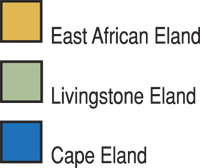 |
 |
Taurotragus oryx pattersonianus
Also called Patterson eland after British Col. J. H. Patterson, who slew the notorious man-eating lions of Tsavo, Kenya.
DESCRIPTION Somewhat darker and more rufus than the Cape and Livingstone elands, with the females more brightly colored. The white body stripes are plainly visible. There is a dark band on the backs of the forelegs above the knees, and the backs of the pasterns are brownish black. Younger adult males have a dark, narrow forehead tuft flanked with orange, and an incomplete white chevron below the eyes. The white face markings disappear in older bulls as the narrow frontal tuft grows into a broad, long-haired bush. East African eland usually have smaller horns than Cape or Livingstone elands.
DISTRIBUTION Southeastern Sudan, southwestern Ethiopia, southwestern and northeastern Uganda, southern and western Kenya, and Tanzania.
Some believe that the eland of southern Tanzania should be classified as Livingstone eland because their horns are larger than those of other eland in East Africa, and the white facial chevron is minimal or missing altogether in most individuals. It would be difficult, however, to establish a boundary between livingstonei and pattersonianus within Tanzania, as natural barriers are lacking, and there are broad overlap areas where the subspecies blend. Therefore, for record-keeping purposes, we consider all eland in Tanzania to be East African eland.
TAXONOMIC NOTES Includes pattersonianus (Kenya) and billingae (Tanzania), with pattersonianus Lydekker, 1906 having priority.
|





